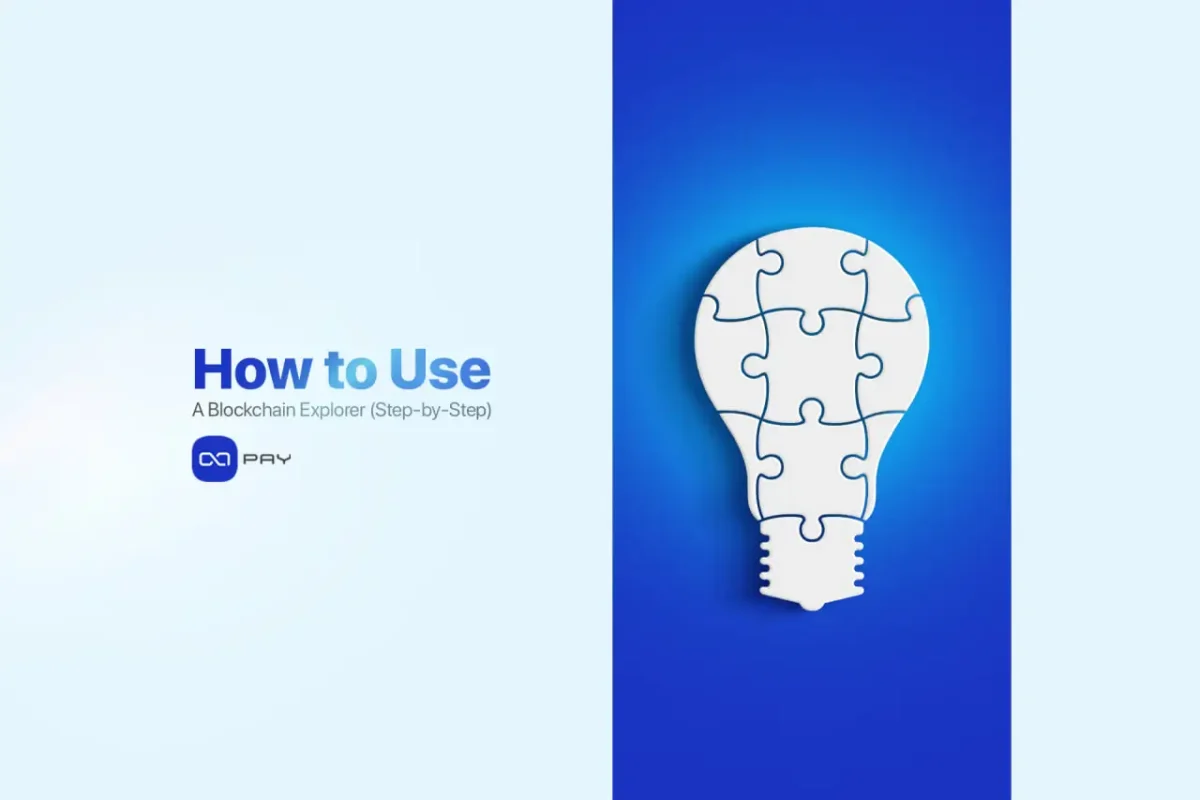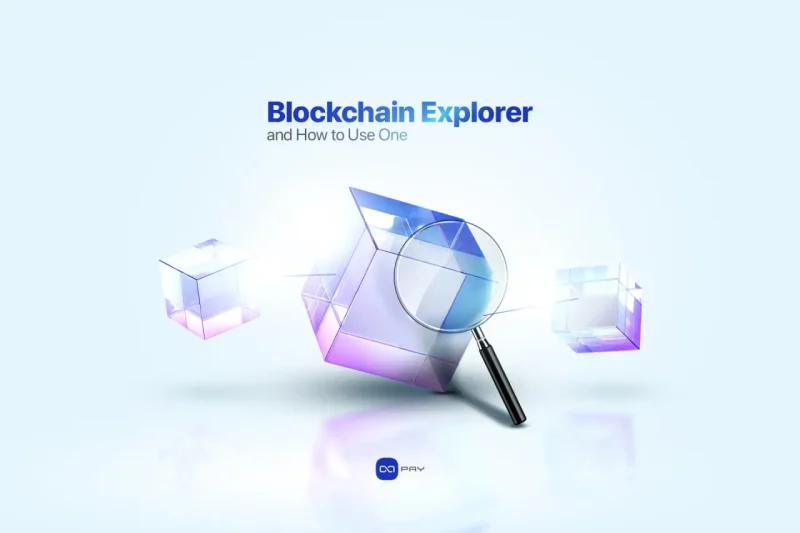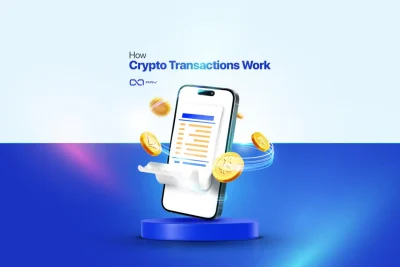Una de las promesas clave de la tecnología blockchain es transparencia, Cada transacción, contrato e interacción con la cartera queda registrada y almacenada para siempre. Pero, ¿cómo se hace realmente? ver ¿Qué está pasando en la cadena de bloques? Ahí es donde entra en juego un explorador de cadenas de bloques.
A explorador de blockchain Es una herramienta que permite a cualquier persona ver información detallada sobre bloques, transacciones, direcciones de billetera y contratos inteligentes en tiempo real. Ya seas usuario de criptomonedas, desarrollador o empresa. aceptando pagos con criptomonedasSaber cómo utilizar un explorador de blockchain es una habilidad esencial.
¿Qué es un explorador de blockchain?
A explorador de blockchain Es una aplicación web que permite buscar y explorar datos de blockchain. Se conecta directamente a un nodo o base de datos de blockchain y muestra el historial de transacciones, los tiempos de creación de bloques, la actividad de la cartera y mucho más, todo en un formato legible.
Cada blockchain tiene sus propios exploradores. Por ejemplo:
- Bitcoin:blockchair.com, btcscan.org
- Ethereum: etherscan.io
- Trón: tronscan.org
- Polígono: polygonscan.com
- Solana: solscan.io
Estas herramientas sirven como portales públicos y neutrales a los datos en cadena de bloques, sin inicios de sesión ni barreras.
¿Qué puedes hacer con un explorador de blockchain?
Los exploradores de blockchain te permiten ver mucho más que solo los saldos de tu billetera. Estas son las funciones más comunes:
Buscar una transacción
Pegue un hash de transacción (TXID) para verificar su estado, número de confirmaciones, remitente y receptor, monto enviado, Tarifas de gas, y el bloque exacto en el que fue incluido.
Seguimiento de la actividad de la billetera
Introduce cualquier dirección de monedero para ver su historial completo de transacciones, saldos de tokens, actividad de NFT e interacción con contratos inteligentes, útil para monitorizar monederos personales y empresariales.
Monitorear el estado de la red
Vea datos en vivo como tiempo de bloqueo, congestión de la red, transacciones pendientes (grupo de memoria), tarifas promedio y precios actuales del gas para evaluar el rendimiento o los retrasos de la cadena de bloques.
Comprobar contratos inteligentes
Explore las direcciones de contrato para leer el código fuente verificado, ver llamadas a métodos, revisar interacciones y monitorear cómo los usuarios y las dApps interactúan con las aplicaciones descentralizadas.
Rastrear pagos o errores
Siga el rastro completo de un pago de criptomonedas, desde el remitente hasta el destinatario final, lo que ayuda a resolver disputas, detectar errores o verificar que los fondos llegaron al destino previsto.
Ver transferencias de tokens
En la mayoría de los exploradores, puedes ver la actividad de tokens por separado de las transacciones de monedas. Simplemente introduce la dirección de una billetera y cambia a... Transferencias de tokens Pestaña. Aquí verás todos los tokens ERC-20 o TRC-20 enviados o recibidos, incluyendo el nombre, la cantidad y la marca de tiempo del token.
Esto resulta especialmente útil para el seguimiento de stablecoins como USDT o tokens de plataforma. También puedes hacer clic en un token para ver su suministro total, titulares y transferencias recientes, lo cual es útil para auditar pagos o verificar detalles de contratos.
Por qué los exploradores de blockchain son importantes para las empresas
Para las empresas que aceptan criptomonedas, los exploradores de blockchain no son solo herramientas técnicas, sino activos operativos.
1. Verificación de la transacción
Cuando un cliente dice "Envié el pago", no necesita adivinar. Pegue el hash de la transacción y confirme:
- ¿Se envió la transacción?
- ¿Quedó confirmado?
- ¿La cantidad fue correcta?
Esto reduce las disputas y genera confianza.
2. Monitoreo de pagos
Si su sistema aún no tiene devoluciones de llamadas automatizadas o webhooks, los exploradores dejan que su equipo de soporte rastrear manualmente pagos en tiempo real.
3. Auditoría y conciliación
Utilice exploradores para conciliar los pagos en cadena con los registros internos. Puede verificar las transacciones entrantes y salientes, así como las marcas de tiempo para los informes de cumplimiento.
4. Transparencia de las donaciones y los pagos públicos
Si eres Aceptar criptomonedas para recaudar fondos o donaciones, puede compartir públicamente la actividad de la billetera Para demostrar transparencia. Esto aumenta la credibilidad y la confianza de los donantes.
5. Detección y análisis de fraudes
Realice un seguimiento de actividades sospechosas, verifique transferencias de tokens desconocidas o rastree fondos en investigaciones de fraude.
Cómo usar un explorador de blockchain (paso a paso)
Aquí tienes una sencilla guía paso a paso que te permitirá utilizarla. Etherscan A modo de ejemplo:
🔍1. Busca la dirección de una billetera
- Ir a etherscan.io
- Ingrese cualquier dirección de billetera Ethereum
- Vea el historial completo de transacciones, saldos de tokens, tenencias de NFT y más
🔍2. Verificar el hash de una transacción
- Pegar un Identificador de transmisión Para ver:
- Direcciones de origen/destino
- Valor enviado
- Gas utilizado y tarifas pagadas
- Estado actual (pendiente, exitoso, fallido)
🔍 3. Explorar tokens
- Buscar un token por nombre o dirección de contrato
- Ver oferta total, titulares, transferencias recientes
🔍 4. Verificar las interacciones del contrato
- Busque una dirección de contrato para:
- Leer el código del contrato (si está verificado)
- Ver llamadas a funciones
- Seguimiento de interacciones a lo largo del tiempo
Estos pasos se aplican a la mayoría de los exploradores principales, como BscScan, TronScan y PolygonScan, con solo pequeñas diferencias de interfaz.

Cómo identificar transacciones fraudulentas o sospechosas mediante exploradores
Los exploradores de blockchain no solo sirven para rastrear pagos, sino que son herramientas poderosas para detectar actividades inusuales o maliciosas. Con un poco de atención, los usuarios y las empresas pueden identificar señales de alerta antes de interactuar con billeteras o tokens inseguros.
1. Verificar transferencias de tokens desconocidos
Si de repente ves un token desconocido en tu billetera, podría ser un lanzamiento aéreo de spam o parte de un intento de phishingEstos tokens pueden vincularse a sitios web falsos o contratos maliciosos.
🔍Utilice el explorador para:
- Haga clic en el token y revise la dirección del contrato.
- Verifique que el nombre del token no tenga un formato extraño o una marca imitadora.
- Vea si otros están recibiendo el mismo token en masa (una señal común de spam).
2. Revisar el historial de interacciones de la billetera
Antes de interactuar con una nueva billetera o aceptar un pago, pegue la dirección en un explorador y revise su actividad pasada.
Las señales de alerta incluyen:
- Pequeñas transferencias frecuentes desde cientos de billeteras (usadas en ataques de polvo).
- Interacción con contratos o mezcladores de alto riesgo.
- Picos de saldo repentinos debido a tokens desconocidos.
3. Analizar el comportamiento de los contratos inteligentes
Si está a punto de aprobar un contrato inteligente (para staking, swaps o DeFi), use el explorador para:
- Ver si el contrato es verificado y tiene código fuente legible.
- Revisa las transacciones recientes, ¿se están perdiendo fondos? ¿Solo interactúan bots?
Los contratos no verificados o aquellos con solo tokens entrantes y ningún retiro pueden ser sospechosos.
4. Utilice herramientas de riesgo basadas en Explorer
Algunos exploradores (como Etherscan) incluyen etiquetas integradas como "Phishing", "Estafa" o "Token falso" en las direcciones reportadas. También puedes usar extensiones como Revocar efectivo o escáneres de terceros que analizan el riesgo del contrato en función del comportamiento en la cadena.
Al aprender a interpretar estos patrones en un explorador de criptomonedas, tanto particulares como empresas pueden evitar estafas comunes, detectar fondos sospechosos y mantenerse más seguros en el ecosistema cripto, antes de que sea demasiado tarde.
Consejo de OxaPay: Utilice exploradores para la verificación manual
Mientras OxaPay manijas Pagos de criptomonedas automáticamente a través de API En el caso de las devoluciones de llamada y los sistemas internos, hay momentos en los que resulta útil utilizar un explorador de blockchain, por ejemplo:
- Cuando un cliente paga directamente a una dirección estática
- Al confirmar una transacción retrasada o pagada de menos
- Al resolver problemas de billetera informados por un usuario
En estos casos, los exploradores ayudan a verificar lo que realmente está sucediendo en la cadena de bloques, sin necesidad de suposiciones.
¿Qué hacen las devoluciones de llamadas API?
Cuando se produce una transacción, Devoluciones de llamadas de API Notifica automáticamente a tu sistema sobre su estado (confirmado, fallido o con pago insuficiente) sin necesidad de comprobaciones manuales. Esto permite actualizaciones en tiempo real, un procesamiento de pedidos más rápido y una automatización más fluida.
Reflexiones finales
Los exploradores de blockchain permiten a cualquier persona leer los datos de la cadena de bloques de forma clara, sin necesidad de conocimientos técnicos. A lo largo de esta guía, hemos explorado cómo los exploradores ayudan a rastrear transacciones, ver la actividad de las carteras, analizar contratos e interpretar el comportamiento de la red de una manera práctica y accesible tanto para usuarios como para operadores.
Para las empresas que utilizan criptomonedas, especialmente con plataformas como OxaPayAprender a leer exploradores añade un nivel adicional de control. Incluso con herramientas automatizadas como las devoluciones de llamadas de API, saber cómo verificar una transacción manualmente ayuda a resolver problemas, confirmar casos extremos y generar confianza en tus operaciones con criptomonedas.
👉 Visita Plataforma de pagos de criptomonedas OxaPay para explorar herramientas diseñadas para necesidades comerciales reales.




